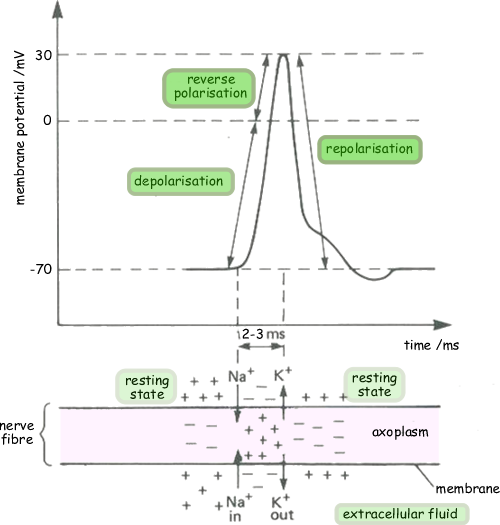Action Potential
Action Potential
When a nerve, muscle or gland cell responds to a stimulus, the membrane potential exhibits a series of reversible changes:
- depolarisation,
- reverse polarisation and finally
- repolarisation.
This sequence constitutes an 'action potential'
Ion Movement through the Membrane

Resting state - polarised
When the cell is in a resting state, the cell membrane keeps sodium ions outside the cell so the interior is negative relative to the exterior. The cell membrane is then said to be polarised.
Depolarisation and Reverse polarisation
When a nerve cell is stimulated, the cell membrane suddenly becomes permeable to Na+ ions which then move into the axoplasm from their higher concentration area outside The increase in positive charge inside the cell leads to a change in the membrane potential from about -70mV to +30mV.
Repolarisation
Almost immediately, the membrane becomes impermeable to Na+ ions and permeable to K+ ions, which consequently leave their high concentration area inside the fibre and move out, thereby restoring the original membrane potential of -70mV.
The Na+ and K+ ions are re-exchanged later during a slower recovery period. This takes about 50 milliseconds or so. This prevents the stimulus from backfiring and ensures that this section of the membrane is ready to receive and transmit the next impulse.
Propagation of the signal
The depolarised (active) region of a fibre acts as a trigger, stimulating adjacent region to follow through the same action potential. How fast the action potential moves along the axon depends on several factors including type of cell, fibre diameter and temperature.
In this way the electrical impulse moves away from where it was received and is transmitted across the main part of the cell, along the axon and on to the synapse at the end of the axon.


